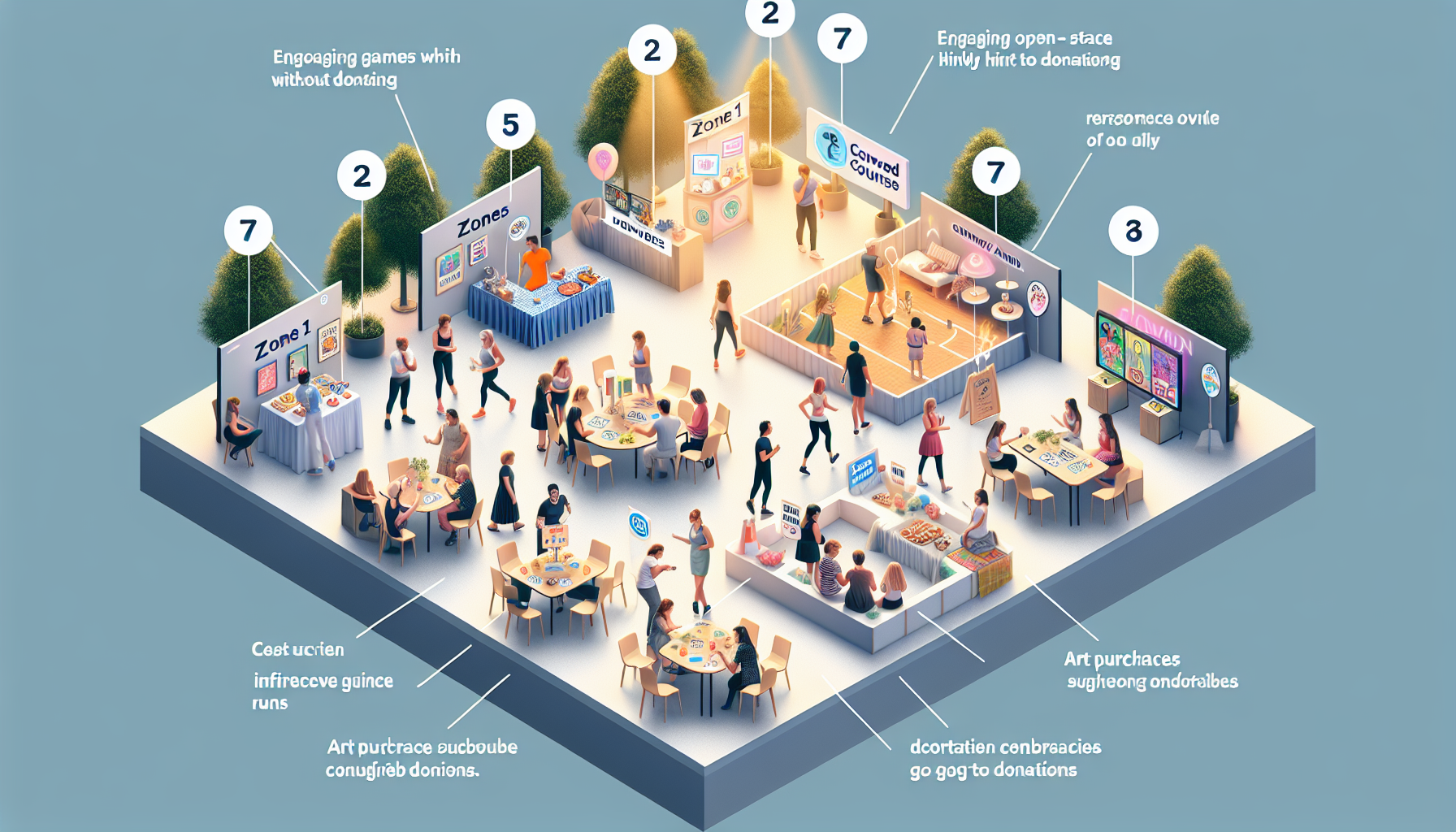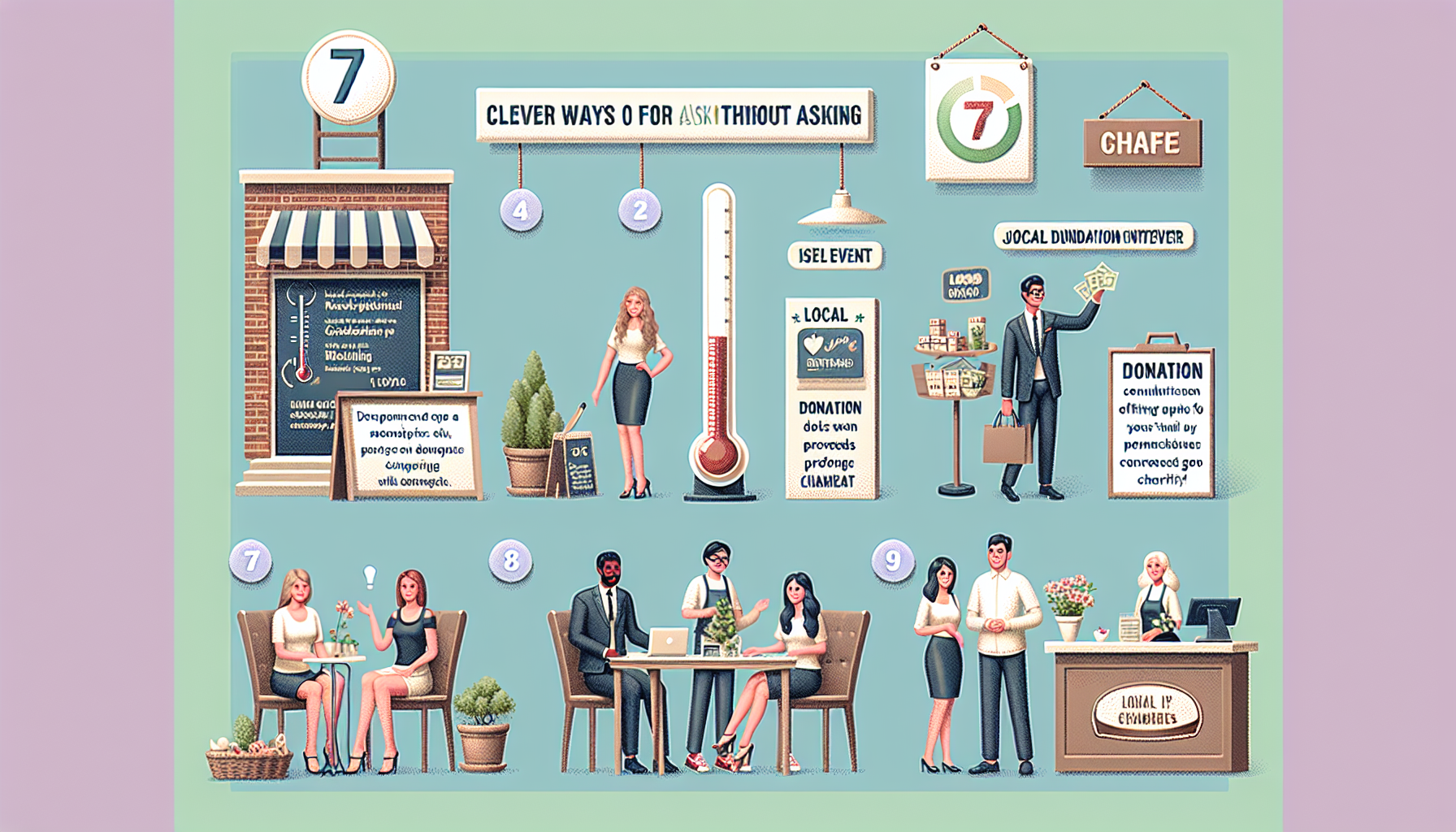Asking for donations can feel awkward and uncomfortable. Many nonprofits struggle with how to approach potential donors without directly asking for money. This often leads to missed opportunities for support. Instead of making a straightforward request, organizations can create engaging experiences that naturally encourage giving. By focusing on storytelling and building relationships, nonprofits can inspire their supporters to contribute without the need for a direct ask.
Here’s what you’ll learn in this blog post:
- The role of storytelling in connecting with donors.
- How to foster meaningful relationships with potential supporters.
- Creative strategies to engage your audience and drive donations.
Understanding the Concept of “How to Ask for Donations Without Asking”
The idea of how to ask for donations without asking revolves around creating a genuine connection with supporters. Nonprofits can share compelling stories about their mission and the impact of their work. This approach allows organizations to showcase their value and inspire potential donors without putting them on the spot.
When people feel emotionally connected to a cause, they are more likely to contribute. By focusing on storytelling and relationship-building, nonprofits can create an environment where giving feels natural. This method not only encourages donations but also fosters long-term support from engaged community members.

The Importance of Storytelling in Fundraising
Storytelling is a powerful tool in fundraising. It helps to convey the mission and vision of a nonprofit in a relatable way. When organizations share stories of those they help, it creates an emotional connection with potential donors. For example, a nonprofit that supports homeless families might share a story about a family who found shelter and stability through their services.
These narratives not only illustrate the impact of donations but also make the cause more tangible. According to a study by the Harvard Business Review, stories can increase empathy and drive action. By highlighting real-life experiences, nonprofits can show supporters exactly how their contributions make a difference.
Building Relationships with Potential Donors
Building relationships with potential donors is essential for long-term success. It’s important for nonprofits to engage with their audience regularly. This can be done through newsletters, social media interactions, or community events. By nurturing these connections, organizations can create a loyal supporter base.
One effective strategy is to personalize communications. Sending tailored messages that acknowledge past support or highlight shared values can strengthen bonds. Additionally, inviting supporters to participate in events or volunteer opportunities fosters a sense of community. When donors feel valued and involved, they are more likely to contribute to the cause.
Share Impactful Stories
Sharing impactful stories is a vital strategy for nonprofits looking to engage potential donors. These narratives can illustrate the direct impact of donations on individuals and communities. For instance, instead of simply stating that a nonprofit provides meals, they could share a story about a child who received food through their program. By putting a face to the cause, the organization makes it relatable and memorable.
Emphasizing emotional connections in these stories can inspire action. When supporters hear about the real-life changes their contributions can make, they are more likely to feel compelled to donate. This approach creates a sense of urgency and importance around the mission, motivating people to get involved and support the cause.
Highlight Success Stories from Beneficiaries
Highlighting success stories from beneficiaries offers a powerful way to showcase the effectiveness of a nonprofit’s work. These stories not only celebrate the achievements of individuals but also serve as testimonials to the organization’s impact. For example, a nonprofit focused on education might feature a student who overcame challenges and graduated with honors thanks to their programs.
These success stories can be shared through various channels, including newsletters, social media, and events. When potential donors see tangible results, they gain confidence in the organization’s ability to use their contributions wisely. This transparency builds trust and encourages ongoing support from the community.
Use Visuals to Enhance Storytelling
Using visuals to enhance storytelling can significantly boost engagement and understanding. Images, videos, and infographics can convey emotions and facts more effectively than words alone. For instance, a video showing a day in the life of a beneficiary can create a powerful connection with viewers.
Visuals also help break down complex information into digestible formats. A well-designed infographic illustrating the impact of donations can quickly communicate key statistics and successes. When paired with compelling narratives, these visuals can captivate an audience and motivate them to contribute.

Create Engaging Social Media Content
Creating engaging social media content is essential for nonprofits looking to connect with their audience. Platforms like Facebook, Instagram, and Twitter provide opportunities to share stories and updates in real-time. By posting regular content that highlights the organization’s mission, successes, and events, nonprofits can keep their supporters informed and involved.
Using a mix of formats, such as videos, images, and live streams, can capture attention and encourage interaction. For example, sharing a heartfelt story through a short video can evoke emotions and inspire viewers to contribute. Engaging content not only keeps current supporters interested but also attracts new followers who may be inclined to donate.
Use Polls and Questions to Spark Interest
Polls and questions are effective tools for sparking interest and engagement on social media. By asking followers for their opinions or insights, nonprofits can create a sense of community and involvement. For instance, a nonprofit could post a poll asking followers which program they believe has the most significant impact.
This approach not only encourages interaction but also provides valuable feedback. It shows supporters that their voices matter, fostering a stronger connection with the organization. Additionally, these interactions can lead to increased visibility, as engaged users are more likely to share the content with their networks, potentially reaching new donors.
Share Behind-the-Scenes Moments
Sharing behind-the-scenes moments gives supporters a glimpse into the daily operations of a nonprofit. This transparency can humanize the organization and build trust with potential donors. For example, posting photos of staff members preparing for an event or volunteers sorting donations can make the work feel relatable and accessible.
These candid moments create a narrative that supporters can connect with, making them feel like part of the team. Highlighting the dedication and passion of those involved can inspire others to get involved, whether through volunteering or donating. Showing the hard work behind the scenes emphasizes the importance of community support in achieving the organization’s goals.
Host a Community Event
Hosting a community event is a fantastic way for nonprofits to engage with supporters and raise awareness about their cause. These events can take many forms, from charity walks and fundraisers to open houses and workshops. The key is to create an inviting atmosphere where attendees feel connected to the mission.
For example, a local animal shelter might host an adoption day featuring fun activities for families. This not only brings the community together but also showcases the organization’s work in a lively, interactive manner. Events like these can spark conversations about the cause and inspire attendees to contribute, whether through donations or volunteering.

Organize Fun Activities that Encourage Participation
Organizing fun activities is an excellent way to encourage participation and foster a sense of community. Nonprofits can plan events that appeal to various interests, such as sports tournaments, art fairs, or family-friendly festivals. These activities create opportunities for people to come together and learn more about the organization in a relaxed setting.
For instance, a nonprofit focused on environmental conservation could host a community clean-up day followed by a picnic. This not only promotes a worthy cause but also allows participants to socialize and connect with others who share their values. Engaging activities make it easy for supporters to get involved and feel invested in the mission.
Provide Opportunities for Informal Conversations
Providing opportunities for informal conversations can help build relationships between nonprofits and their supporters. Creating spaces where attendees can chat casually allows for genuine connections to form. For example, during a community event, setting up cozy seating areas or snack stations encourages people to linger and talk.
These informal interactions can lead to meaningful discussions about the organization’s work and impact. When supporters feel comfortable sharing their thoughts and experiences, it fosters a sense of belonging. This connection can motivate them to contribute, whether through donations or by spreading the word about the nonprofit’s mission.
Leverage Email Newsletters
Leveraging email newsletters is a powerful way for nonprofits to connect with their supporters regularly. By sending out informative and engaging newsletters, organizations can keep their audience updated on events, initiatives, and success stories. This consistent communication helps maintain interest and encourages ongoing support.
For example, a nonprofit might send a monthly newsletter featuring upcoming events, volunteer opportunities, and highlights of recent achievements. Including visuals and personal stories can make the content more appealing. When subscribers see the impact of their contributions, they are more likely to stay engaged and consider donating again.
Share Updates and Milestones
Sharing updates and milestones through email newsletters creates a sense of progress and achievement within the community. Nonprofits can highlight key accomplishments, such as reaching fundraising goals or successfully completing projects. This not only informs supporters but also celebrates their role in making these successes possible.
For instance, a nonprofit that provides educational resources might share news about how many students they’ve helped or new programs they’ve launched. These updates reinforce the value of donor contributions and inspire continued support. When supporters feel like they are part of the journey, they are more likely to remain engaged and invested in the organization’s future.
Include Testimonials from Supporters
Including testimonials from supporters in email newsletters can significantly enhance credibility and trust. These personal stories showcase the positive impact of the nonprofit’s work and demonstrate the community’s commitment. For example, sharing a quote from a volunteer about their rewarding experience can inspire others to get involved.
Testimonials serve as social proof, encouraging potential donors to contribute by showing that others believe in the cause. By featuring diverse voices, nonprofits can resonate with a broader audience. Highlighting these experiences makes the organization’s mission relatable and reinforces the importance of community support in achieving its goals.
Collaborate with Local Businesses
Collaborating with local businesses is an effective strategy for nonprofits to expand their reach and resources. By forming partnerships, organizations can tap into the business’s networks, gaining access to new supporters and potential donors. These collaborations can take many forms, such as sponsorships, joint events, or donation drives.
For example, a nonprofit focused on health might partner with a local gym to offer fitness classes, donating a portion of the proceeds to the cause. This not only raises funds but also increases visibility for both the nonprofit and the business. When local businesses get involved, it creates a sense of community and encourages others to join in supporting the mission.

Partner for Events that Benefit Both Parties
Partnering for events that benefit both parties allows nonprofits and local businesses to create mutually advantageous opportunities. These collaborative events can attract larger crowds, combining the audiences of both organizations. For instance, a local restaurant could host a charity night where a percentage of sales goes to a nonprofit.
Such events not only raise funds but also promote community engagement. Attendees are more likely to support a cause when they see local businesses actively participating. This partnership fosters goodwill and strengthens community ties, encouraging ongoing support for both the nonprofit and the business involved.
Promote Joint Initiatives to Reach Wider Audiences
Promoting joint initiatives is a strategic way for nonprofits and local businesses to reach wider audiences. By working together on marketing efforts, both parties can leverage each other’s platforms to share their message. For example, a nonprofit could collaborate with a local coffee shop to create a special drink, with proceeds supporting the cause.
This initiative can be promoted through social media, email campaigns, and in-store signage, expanding visibility for both organizations. Joint initiatives not only enhance the nonprofit’s reach but also demonstrate the business’s commitment to community involvement. When both entities work together, they can create a greater impact and encourage more people to engage with their missions.
Use Your Website Wisely
Using a nonprofit’s website wisely is crucial for engaging potential donors and supporters. The website serves as the organization’s online hub, providing vital information about its mission, programs, and impact. It should be user-friendly and visually appealing, making it easy for visitors to navigate and find what they need.
Incorporating clear calls-to-action, such as “Donate Now” or “Get Involved,” can encourage visitors to take action. Additionally, showcasing compelling stories and testimonials on the homepage can draw in new supporters. By optimizing the website for both engagement and functionality, nonprofits can effectively communicate their mission and inspire contributions.
Create a Dedicated Stories Page
Creating a dedicated stories page on a nonprofit’s website allows organizations to showcase their impact through compelling narratives. This page can feature success stories, testimonials, and case studies that highlight the difference the organization makes in the community. For instance, sharing a story about a family helped by the nonprofit can resonate with visitors and evoke an emotional response.
This dedicated space not only informs potential donors but also builds trust and transparency. When supporters see real-life examples of how their contributions make a difference, they are more likely to feel motivated to donate. A well-curated stories page can serve as a powerful tool for inspiring action and fostering ongoing support.
Incorporate a Blog Section for Regular Updates
Incorporating a blog section on the nonprofit’s website is an excellent way to provide regular updates and engage with the audience. Through blog posts, organizations can share news, insights, and educational content related to their mission. For example, a nonprofit focused on environmental conservation might write posts about recent projects, upcoming events, or tips for sustainable living.
Regularly updated content keeps the website fresh and encourages visitors to return. It also improves search engine optimization (SEO), helping the organization reach a broader audience. By creating valuable content that resonates with supporters, nonprofits can strengthen their connection with the community and encourage ongoing involvement.
Offer Value Through Educational Content
Offering value through educational content is a powerful way for nonprofits to engage their audience and establish authority in their field. By providing useful information, organizations can attract potential donors who are interested in learning more about the cause. This could include guides, articles, or videos that educate supporters on relevant topics related to the nonprofit’s mission.
For example, a nonprofit focused on mental health might create resources that help individuals understand mental health issues and coping strategies. By sharing this knowledge, the organization demonstrates its commitment to the cause while also building trust with its audience. Educational content not only informs but also empowers supporters to take action, whether through donations or advocacy.

Host Free Workshops or Webinars
Hosting free workshops or webinars is an effective way for nonprofits to provide value while engaging with their community. These events can cover various topics related to the organization’s mission, offering attendees valuable information and skills. For instance, a nonprofit focused on financial literacy might host a workshop teaching budgeting skills to families.
These interactive sessions not only educate participants but also create opportunities for networking and relationship-building. Attendees can connect with the organization and other supporters, fostering a sense of community. When individuals see the nonprofit actively contributing to their growth, they are more likely to feel inclined to support its mission.
Provide Resources Related to Your Cause
Providing resources related to a nonprofit’s cause is essential for empowering supporters and enhancing community engagement. This can include downloadable materials, toolkits, or links to helpful websites that align with the organization’s mission. For example, an environmental nonprofit might offer guides on how to reduce waste or start a community garden.
By making these resources available, nonprofits demonstrate their commitment to education and support. This not only helps individuals take actionable steps but also reinforces the organization’s role as a valuable resource within the community. When supporters feel equipped with knowledge and tools, they are more likely to engage further, whether through donations, volunteering, or advocacy.
Frequently Asked Questions
How do you politely ask for money donations?
Politely asking for money donations involves framing your request in a way that emphasizes the impact of the gift rather than the need for funds. One effective approach is to share a compelling story about how donations have made a difference in the past. For instance, you might say, “Your support helped us provide meals for families in need last month. Would you consider making a donation today to help us continue this vital work?” This method focuses on the positive outcomes of giving rather than simply asking for money.
What are the best phrases to ask for donations?
Using heartfelt phrases can make a significant difference when asking for donations. Some effective phrases include:
- “Your contribution can change lives.”
- “Join us in making a difference today!”
- “Every dollar counts towards our mission.”
- “Help us reach our goal of [specific amount].”
These phrases highlight the impact of the donation and encourage potential supporters to take action without feeling pressured.
How do I ask for donations without begging?
Asking for donations without begging relies on building relationships and sharing stories that resonate with potential donors. Instead of pleading for help, focus on the positive impact their contributions can make. You might say, “We’re excited to share how your support can help us expand our programs and reach more individuals in need.” This approach emphasizes partnership rather than desperation, creating a more inviting atmosphere for giving.
How do I ask for donations without sounding desperate?
To ask for donations without sounding desperate, maintain a confident and positive tone. Share success stories and updates that showcase the organization’s achievements, reinforcing the idea that contributions lead to meaningful change. For example, you could say, “Thanks to our supporters, we recently launched a new initiative that has already helped dozens of families. We invite you to join us in this journey by considering a donation.” This approach highlights progress and opportunity rather than urgency or neediness.
By incorporating these strategies into your outreach, you can effectively engage potential donors while fostering a sense of community and shared purpose.



